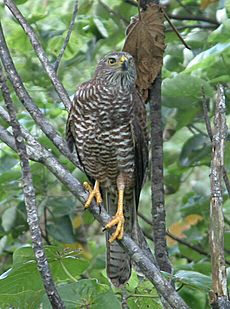Christmas Island flying fox facts for kids
Quick facts for kids Christmas Island flying fox |
|
|---|---|
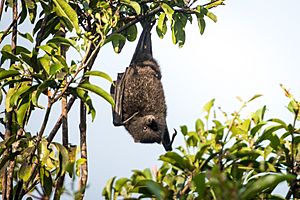 |
|
| Conservation status | |
| Scientific classification |
|
| Kingdom: | Animalia |
| Phylum: | Chordata |
| Class: | Mammalia |
| Order: | Chiroptera |
| Family: | Pteropodidae |
| Genus: | Pteropus |
| Species: | |
| Subspecies: |
P. m. natalis
|
| Trinomial name | |
| Pteropus melanotus natalis Thomas, 1887
|
|
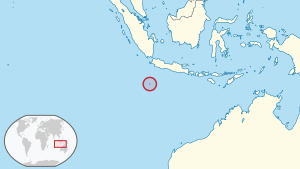 |
|
| Location of Christmas Island | |
| Synonyms | |
|
|
The Christmas Island flying fox or Christmas Island fruit bat is a type of flying fox that lives only on Christmas Island. Scientists are still deciding if it is its own unique species (Pteropus natalis) or a subspecies of the black-eared flying fox (P. melanotus natalis). It might have come from a group of island flying foxes living near Java.
This flying fox is a medium-sized bat, usually weighing between 250 and 500 grams (9 to 18 ounces). It has black fur all over its body. Females usually give birth to one baby, often during the wet season from December to March. The baby can fly by five or six months old. It takes a long time for them to grow up and have their own babies, about 27 or 28 months. This is one of the slowest growth rates for any bat! They are thought to live for 6 to 12 years.
Christmas Island flying foxes fly around the island looking for fruit and nectar to eat. They are very important for the island's plants because they help spread seeds and pollinate flowers. This makes them a keystone species. Unlike most bats, which are active at night, these flying foxes are mostly active during the day.
Sadly, the Christmas Island flying fox is the only native mammal left on the island. Its population has dropped a lot, by 66–75% between 1984 and 2006, and by another 35–39% from 2006 to 2012. It is now critically endangered. This decline might be due to new buildings on the island, invasive species (animals or plants that don't belong there), and phosphate mining. If the population keeps shrinking, these flying foxes could disappear forever very soon.
Contents
About This Flying Fox
What is a Flying Fox?
|
||||||||||||||||||||||||||||||||||||||||||||||||||||||||||||||||||||||||||||||||||||||||||||||||||||||||||||||||||||||||
| The relations of the Christmas Island flying fox with some other flying foxes |
The Christmas Island flying fox was first described in 1887 by a British zoologist named Oldfield Thomas. He called it Pteropus natalis. Later, in 1940, another British zoologist, Frederick Nutter Chasen, suggested it might be a subspecies of the black-eared flying fox.
Even today, scientists are not fully sure if it's a separate species or a subspecies. Its unique home on Christmas Island suggests it might be different enough to be its own species. Genetic studies show it is related to other flying foxes from the Oceania region. It might have come from a group of island flying foxes from Pulau Panjang near Java.
What Does It Look Like?
The Christmas Island flying fox is a medium-sized bat. Its forearm (the bone in its wing) is about 13 centimeters (5 inches) long. It usually weighs between 250 and 500 grams (9 to 18 ounces). Males can be a bit heavier, up to 550 grams (19 ounces). They have a wide snout, short, pointy ears, and short teeth.
Their fur is a shiny deep black. The fur is thick and soft, especially on their head and neck. Some bats have a faint reddish color around their neck. An old British scientist, Charles William Andrews, said that these bats make a loud, harsh screeching sound.
Life on Christmas Island

How They Grow and Reproduce
Like other flying foxes, these bats live a long time and have babies slowly. Females usually give birth to one pup (baby bat). Most births happen from December to February, during the island's wet season. The baby is born after about five months of gestation (pregnancy). It drinks its mother's milk for about four months.
There are three main places on the island where female bats and their pups gather. Since there are more females than males in these groups, it's thought that one male might mate with several females. Males might even fight over females.
A newborn pup has a forearm length of about 5 centimeters (2 inches) and weighs about 55 grams (2 ounces). They grow slowly compared to other flying foxes. Pups can fly when they are about five or six months old. By then, their forearm is about 11 centimeters (4.4 inches) long, and they weigh about 163 grams (5.7 ounces).
Males become ready to have babies around 27 months old, and females around 28 months old. This is one of the oldest ages for any bat to become an adult. For example, the grey-headed flying fox can have babies much earlier. Scientists think this slow growth might be because there aren't many predators on Christmas Island. This means they can take their time growing up and live longer lives.
Where They Live and How Many There Are
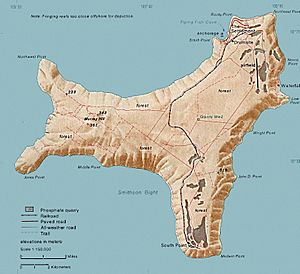
The Christmas Island flying fox lives only on Christmas Island, which is about 135 square kilometers (52 square miles) in size. When the first people settled on the island in the 1890s, they said these bats were very common. In 1897, a scientist reported seeing hundreds of flying foxes covering a dead tree. In 1947, another naturalist said they were so common they were a bit of a problem for fruit crops.
In 1984, a study found about 6,000 flying foxes on the island. About 3,500 of them lived in six large groups called colonies along the coast. The rest were spread out across the island, living alone or in small groups. They like to roost (rest) in 13 different types of trees, often in the windy tops of trees to help them take off easily.
Sadly, the population dropped a lot by 2006. Only about 1,500 to 2,000 bats were left, which was a 66–75% decrease. Three of the six main colonies were empty. The population kept dropping by another 35–39% between 2006 and 2012. This shows that the problems causing their decline have not been fixed.
What They Eat and Who Eats Them
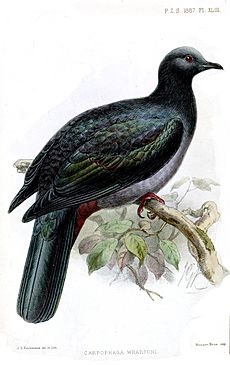
Unlike most bats, the Christmas Island flying fox is active during the day. They usually leave their roosts in the afternoon, often between 5:45 and 6:15 p.m. This is probably because there are not many animals that hunt them on the island.
These bats fly all over the island to find food. They mostly eat fruit and nectar from plants. They get food from 35 native plants and 18 plants that were brought to the island. They especially like fruit from trees like the powder-puff tree, common fig, and beach almond.
The Christmas Island flying fox and the Christmas imperial pigeon are the only main fruit-eating animals on the island. This means the flying foxes are very important for spreading seeds and pollinating plants, making them a keystone species for the island's ecosystem.
The Christmas Island goshawk has been seen attacking and eating the flying fox. The Nankeen kestrel, a bird that arrived on the island around 1950, has also been seen bothering them. Flying foxes can also get tiny bugs called mites on them.
Facing Challenges
Since people first settled on Christmas Island in the 1890s, the island's delicate environment has been harmed. Every other native mammal on the island has disappeared, including the Christmas Island pipistrelle and several types of rats and shrews. The Christmas Island flying fox used to be hunted, but this is now against the law.
Why They Are in Danger
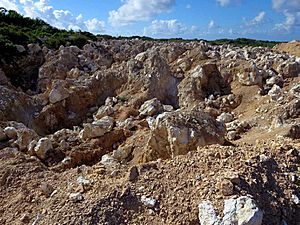
Even though 63% of the island is a nature reserve, new buildings and other changes can still harm the flying fox population. For example, building a casino might have caused bats to leave one of their colonies.
Many invasive species have been brought to Christmas Island. These include the barking gecko, black rat, feral cat, and yellow crazy ants. Feral cats and yellow crazy ants are especially thought to harm flying foxes. Yellow crazy ants spray a harmful acid, and they have formed huge groups called supercolonies. These invasive species can compete with native animals for food, hunt them, or spread diseases.
Strong winds from a storm in 1988 might have also hurt the flying fox population. Phosphate mining on the island creates dust that can contain harmful substances like cadmium. If bats eat this dust, it can make them sick and cause liver problems. One bat colony near a phosphate dryer was abandoned, likely due to the mining activity.
Protecting the Flying Fox
The Christmas Island flying fox is listed as threatened by the International Union for the Conservation of Nature. If it is found to be a unique species, it would be considered critically endangered. Australia protects it under the Environment Protection and Biodiversity Conservation Act 1999, and hunting them became illegal in 1958.
If the population continues to decline at the current rate, the Christmas Island flying fox is likely to become extinct very soon. As of 2015, there is a plan to help the flying fox by getting rid of cats, rats, and ants on the island. This project costs about A$500,000 (about US$342,000).
See also
 In Spanish: Murciélago de la fruta de la Isla de Navidad para niños
In Spanish: Murciélago de la fruta de la Isla de Navidad para niños



